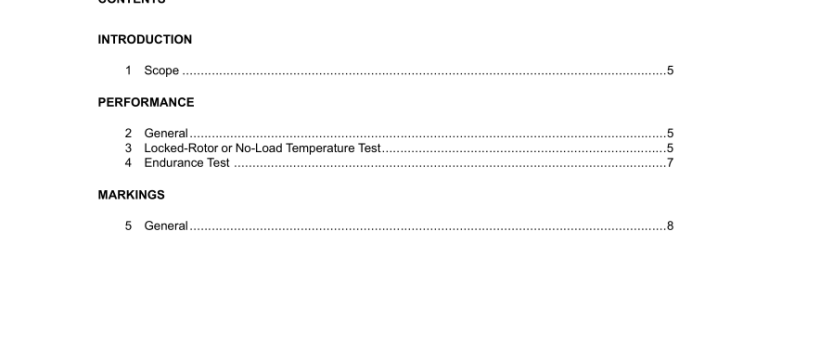UL 1004-2 2020 pdf download.Impedance Protected Motors.
2 General 2.1 A motor that uses alternate major insulation system component materials shall have each material subjected to the Endurance Test, Section 4. Following the tests, the motor shall not exhibit an increased risk of fire or electric shock. Exception: It shall not be necessary to repeat the Endurance Test, Section 4, to evaluate the suitability of the alternate material when all the following are met: a) The alternate major insulation system component is ofthe same geometry, the same polymeric class (thermoplastic/thermoset), and is otherthan the magnet wire; b) The Electrical and Mechanical Tensile Strength RTIs of the alternate material are, at a minimum, equal to the rating ofthe insulation system; and c) The heat deflection temperature forthe alternate material is eitheras high as orhigherthan: 1) The highest temperature plus 10° C recorded during the Locked-Rotor or No-Load Temperature Test, Section 3, conducted on the motororiginally; or 2) The heat deflection temperature forthe original material. 2.2 It shall not be necessary to repeat the Endurance Test, Section 4, for alternate minor insulation system components. 3 Locked-Rotor or No-Load Temperature Test 3.1 Deleted
3.2 The three motors are to be stalled, and the locked rotor wattage of each measured. The same three motors are to be run no-load. The sample exhibiting the highest wattage in either condition is then to be either locked in a stationary position using a means of low thermal conductivity or allowed to run no-load (whichever condition results in the highest wattage consumption). 3.3 Testing of a permanent-split capacitor motor is to be conducted with the capacitor either properly connected in the circuit or short-circuited, whichever results in the higher temperature. Exception No. 1: A motorthat employs an integrally mounted and enclosed capacitoris not required to be tested with the capacitorshort-circuited. Exception No. 2: A motorthat employs a capacitorevaluated to the construction and testing requirements in the Standard forCapacitors, UL 810, is not required to be tested with the capacitorshort-circuited. 3.4 Temperatures are to be measured: a) By the change-in-resistance method; or b) With a thermocouple applied directly to the actual conductor material, integrally applied conductor insulation, or coil wrap, as applicable. 3.5 Starting at room temperature, the motor is to be energized continuously for 72 hours, during which the winding temperatures are to be monitored continuously until thermal equilibrium is attained and then continuously for the final hour. Exception: The test may be discontinued when the winding temperatures normalized to 40°C (104°F) stabilize at a constant temperature not exceeding the maximum temperature for the insulation class as specified in Table 32.1 ofUL 1004-1. The Endurance Test, Section 4, is not required to be performed.
3.7 A polyphase motor shall additionally be tested under single phasing conditions. The motor is to be energized with one supply conductor open circuited. For asymmetrical motor windings, the test is to be repeated until all phases have been singly opened. 3.8 At the request of the manufacturer, the test in this Section is to be conducted under such conditions that result in the motor coils operating at the maximum temperature for the insulation class specified in Table 3.1. The maximum temperature is to be obtained by: a) Increasing the test voltage; b) Increasing the ambient temperature; c) Using test samples constructed so that they maintain the maximum temperature; or d) Any other equivalent means. This test shall not be conducted by increasing the voltage for motors with the capacitor shorted. 3.9 When a “worst-case” condition (such as speed of a multi-speed motor or frequency) is not evident, a motor shall be tested at each condition until thermal stabilization. The condition resulting in the highest operating temperature is then to be subjected to the full Locked Rotor or No-Load Temperature Test, Section 3, and Endurance Test, Section 4. 3.10 Immediately following the conclusion of the Locked-Rotor or No-Load Temperature Test, and while still in a heated state, a motor shall be subjected to the Dielectric Voltage-Withstand Test, Section 37, of UL 1004-1.UL 1004-2 2020 pdf download.
UL 1004-2-2020 pdf download
